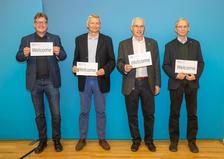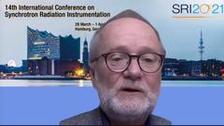At the opening ceremony of the virtual SRI conference: DESY and European-XFEL scientists and directors Christian Schroer, Thomas Tschentscher, Helmut Dosch and Edgar Weckert. (Image: DESY, Marta Mayer)
Back in Hamburg after 40 years, albeit virtually: the SRI2021 conference organised by DESY and the European XFEL starts today. Scientists from all over the world have been meeting every three years since 1982 for SRI – the International Conference on Synchrotron Radiation Instrumentation. At one of the largest exchange forums in this field of research, they discuss the latest developments in technologies, instrumentation and research.
SRI2021 had originally been scheduled to take place last summer in Hamburg. However, due to the pandemic, it was postponed until spring 2022. With the pandemic still not over, the organisers and the international conference committee took the difficult decision not to postpone the conference again, but to hold it online instead. So from 28 March to 1 April 2022, more than 1160 international participants meet virtually.
'The success story began at DESY 40 years ago with the first SRI conference, so I am very pleased that it is being organised by Hamburg institutes again this year. The SRI conference sets an example for international cooperation in science,' says Helmut Dosch, Chairman of the DESY Board of Directors. 'In the 40 years of SRI history, the field of instrumentation for synchrotron radiation sources has developed extremely dynamically, which is mirrored in the high number of participants. Today, we can carry out investigations with our light sources that we wouldn’t have dared to dream of in 1982. I am excited to see what further developments will come in the future and will be presented at the SRI this week.'
European XFEL Managing Director Prof. Robert Feidenhans'l: 'With the war in Ukraine triggered by Russia, everyday life in research is also changing. We at European XFEL are experiencing this particularly strongly at the moment. This makes the exchange with colleagues who share our universal values all the more important. Research and development for X-ray light sources is doing extraordinary things in a field that contributes significantly to gaining knowledge in basic research and to solving important questions for the future. I am very proud to welcome so many participants. Let us use the conference to strengthen our contacts and work together even more consciously for peace and a better future.'
Forty years ago, DORIS was the only synchrotron radiation source in Hamburg. Today, there are three unique and outstanding research facilities that attract users to the Hamburg metropolitan region: the world's most powerful X-ray laser European XFEL, PETRA III, one of the brightest storage ring-based X-ray radiation sources in the world, and the world's first free-electron laser in the soft X-ray range FLASH. SRI provides a common forum for the scientists and users of the more than 50 operating or planned synchrotron radiation light sources and free-electron lasers from around the world, and also aims to bridge the gap to other disciplines and innovation.
The research areas that are now in focus at the SRI conference have become much more diverse. The ultra-short and precise flashes of light offer a wide range of exciting opportunities for investigation, from materials research to medical applications. At the same time, they pose great challenges for instrumentation and analytical methods. In the last ten to fifteen years, new FEL sources have opened up completely new experimental possibilities for studying atomic phenomena at ultrashort timescales. At the same time, the ongoing revolution in the design of storage ring sources, which has led to a new generation, means that beam properties have improved enormously, benefiting especially those methods that observe at the nanometre scale. One focus of the contributions to SRI2021 deals with the associated technical challenges and new experimental methods.
The next SRI conference will take place in Hamburg in 2024, this time in person.
(from DESY News)








